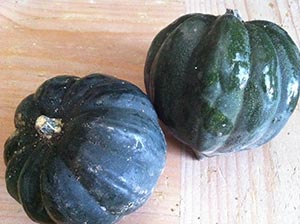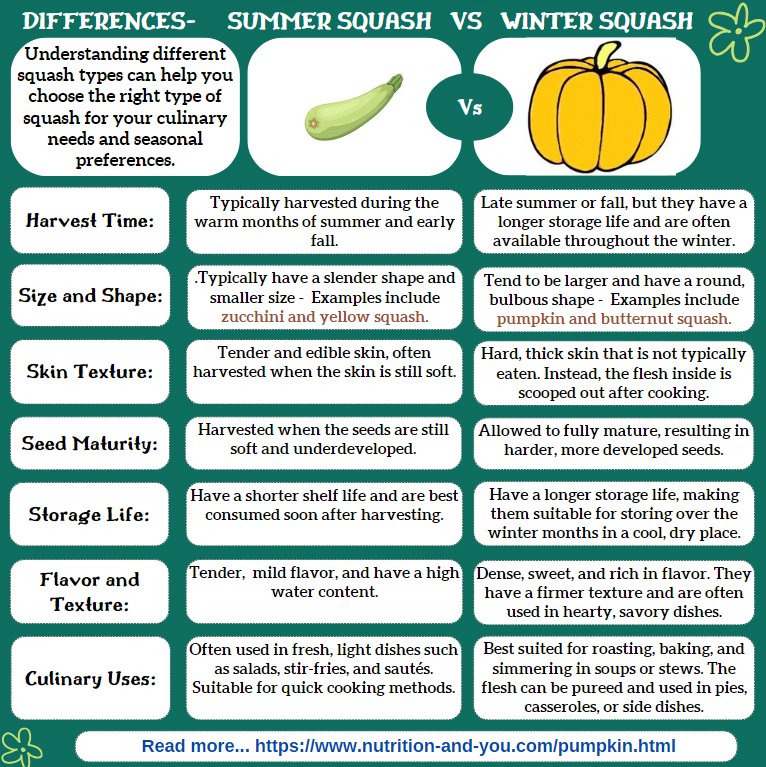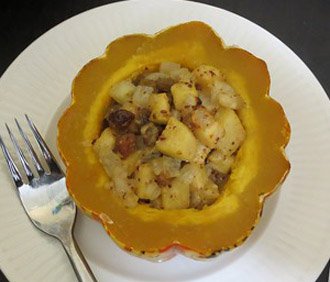Acorn squash Nutrition facts
Acorn squash is another popular winter-squash variety vegetables like pumpkin, and butternut squash in the US. The squash is named so because of its shape; disc-like flat upper end, and angled, elongated lower pavilion.
Botanically, it belongs to the Cucurbitaceae (Gourd family) of vegetables, and is closely related to other winter squash varieties such as pumpkin, delicata, butternut squash, hubbard, spaghetti, Japanese kuri hokkaido, calabaza, etc.
Scientific name: C. pepo var. turbinata.
 |
| Acorn squash. Note for deep lobed, dark green fruits. Courtesy: twistedstringknits |
Acorn prefers well-drained, organic, sandy soils for adequate growth. A completely matured acorn measures about 4 inches across, 7 inches in length, and weighs about 400 to 700 grams.
Its outer deep green skin is marked by ridges that run lengthwise. As in other winter squash types, acorn squash also features hard, tough skin. After about 35-40 days after plantation, yellow flowers appear, which soon develop into attractive, elongated fruit pods.
They come in a variety of colors and sizes dark green, yellow, yellow-orange, variegated; however, the most common type of acorn squash is dark green type. Inside, however, the flesh of acorn squash is golden-yellow, just as in pumpkins.
Apart from its fruits, winter squash blossoms, including acorn flowers, are popular items in the kitchen and are normally used to make a side dish.
Male blossoms are generally picked up while female blossoms are left for fruiting. Few farmers, however, pick small numbers of female flowers with intact, very tiny fruit (baby acorn squash) to sell in the markets, and indeed, command a higher price. Acorn greens (tips and tendrils) are also enjoyed in some South-eastern countries and the Philippines.
See the differences between Summer and Winter variety squashes in an infographic:
 |
Health benefits of Acorn squash
Acorn squash nutrition is relatively higher in calories than pumpkin and pattypans. 100 grams of raw fruit holds 40 calories; almost the same as that of butternuts (45 cal). It carries no saturated fats or cholesterol. Also, its peel is a good source of dietary fiber.
Acorn squash is free of gluten; a protein molecule in foods that causes severe food intolerance in non-celiac (gluten sensitivity) as well as celiac disease patients. It is one of the better alternative food substitutes for people suffering from a spectrum of gluten-related disorders.
Fresh fruits carry relatively modest amounts of vitamin-A than pumpkin; provide about 367 IU per 100 g. Vitamin-A is important for cell growth and development, and for good vision.
Unlike other winter squash types like pumpkin and butternut squash, acorn is a modest source of flavonoid poly-phenolic antioxidants such as carotenes, lutein, and zeaxanthin.
Together with vitamin-A, pigment compounds help scavenge harmful oxygen-derived free radicals and reactive oxygen species (ROS) from the body that play a role in aging and various disease processes.
Fresh acorn holds relatively more amounts of vitamin C (18% of RDA /100 g), pyridoxine, and thiamin than pumpkin. Vitamin C is essential for collagen synthesis in bones, cartilage, and blood vessels, and aids in the absorption of iron.
It provides 17 µg or 4% of RDA per 100 gm of folates. Folate is a necessary element for cell division and DNA synthesis. When taken adequately during early pregnancy, it may help prevent neural tube defects in the newborn.
Like other winter squash varieties, acorn fruit also has less sodium (1 mg/100 g) but good amounts of potassium (347 mg/100 g), an important intra-cellular electrolyte. Potassium is a heart-friendly electrolyte and helps bring the reduction in blood pressure and heart rates by countering the pressing effects of sodium.
Further, acorn squash carries modest levels of other B-complex groups of vitamins like pantothenic acid, riboflavin, and minerals like calcium, iron, manganese, phosphorus, and zinc.
| Principle | Nutrient Value | Percent of RDA |
|---|---|---|
| Energy | 40 Kcal | 2% |
| Carbohydrates | 10.42 g | 8% |
| Protein | 0.80 g | 1% |
| Total Fat | 0.10 g | <1% |
| Cholesterol | 0 mg | 0% |
| Dietary Fiber | 1.5 g | 4% |
| Vitamins | ||
| Folates | 17 μg | 4% |
| Niacin | 0.700 mg | 4% |
| Pantothenic acid | 0.400 mg | 8% |
| Pyridoxine | 0.154 mg | 12% |
| Riboflavin | 0.010 mg | <1% |
| Thiamin | 0.140 mg | 12% |
| Vitamin-A | 367 IU | 12% |
| Vitamin-C | 11 mg | 18% |
| Electrolytes | ||
| Sodium | 3 mg | <0.5% |
| Potassium | 347 mg | 7% |
| Minerals | ||
| Calcium | 33 mg | 3% |
| Iron | 0.70 mg | 9% |
| Magnesium | 32 mg | 8% |
| Manganese | 0.167 mg | 6% |
| Phosphorus | 36 mg | 5% |
| Selenium | 0.5 µg | <1% |
| Zinc | 0.13 mg | 1% |
| Phyto-nutrients | ||
| Carotene-ß | 220 μg | -- |
| Crypto-xanthin-ß | 0 μg | -- |
| Lutein-zeaxanthin | 38 μg | -- |
Selection and storage
Acorn squash available around the year in the markets. Buy fresh, medium-size fruits with intact stems. Avoid damage, cuts and punctured, spots, bruise, etc.
At home, cured acorn squash can stay fresh up to 3 months when kept in a cool, dry storage area you do for other winter squash like butternut, pumpkin, etc.
Cut sections, however, should be used immediately. Or else, you may prefer to keep inside a plastic wrap in the refrigerator set at high relative humidity for extended use (for 2-3 days).
Preparation and serving methods
At home, wash fruits in cold water to remove any surface sand and dirt. Trim the stem end. Being a winter squash member, the acorn has tough skin, which should be peeled carefully using a knife.
Cut the fruit into small cubes, wedges, or just in halves as you may desire to use them in cooking. It is sought after in a variety of recipes such as mashed, pureed, stuffed, grilled, roasted, etc.
As in other squash, acorn flowers, baby fruits, and young tender shoots and tendrils are also an edible delicacy. In general, male blossoms are picked up for making fritters, stuffing, etc. To prepare, open up flowers and carefully inspect for insects. Pull off any calyces firmly attached at the base.
 |
| Acorn squash stuffing recipe. Courtesy: mlcastle. |
Here are some serving tips:
Fresh, tender, thin slices of acorn squash can be added to vegetable salads.
The squash blossoms dipped in chick-pea flour batter, fried in oil, and enjoyed as delicious snacks.
As in pumpkin, it can be employed in pies, casseroles, cakes, pudding, etc.
Pureed acorn squash blended with onion, carrot, and garlic to make a delicious soup.
The fruit cut in halves, scooped off seeds and stuffed with cheese, mushrooms, and herbs, and baked in the oven.
Acorn squash kernels can be eaten as a snack. Simply toast the seeds in the oven and enjoy!
Safety profile
Allergic reactions to acorn squash are rare. Pregnant women and infants can safely consume it. (Medical disclaimer).
≺≺- Also read Spaghetti squash nutrition facts.
≺≺ -Back to Vegetables from Acorn Squash nutrition. Visit here for an impressive list of vegetables with complete illustrations of their nutrition facts and health benefits.
≺≺ -Back to Home page.
Further reading:
Texas A&M AgriLife Extension (PDF).